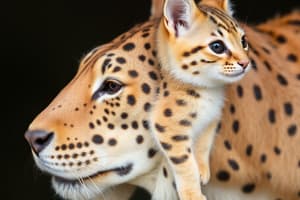Podcast
Questions and Answers
What are some of the characteristics used as criteria for animal classification?
What are some of the characteristics used as criteria for animal classification?
- Favorite type of habitat
- Hunting technique and prey selection
- Fur color and pattern
- Anatomy, behavior, and diet (correct)
Which level of classification provides the finest distinction among closely related organisms?
Which level of classification provides the finest distinction among closely related organisms?
- Family (correct)
- Order
- Genus
- Class
How has classification of animals evolved over time?
How has classification of animals evolved over time?
- It has only relied on habitat as a classification criterion
- It has stayed static without any changes
- It has become more comprehensive based on biology, genetics, and evolutionary relationships (correct)
- It has become less detailed and specific
Which of the following is NOT a classification criterion for animals?
Which of the following is NOT a classification criterion for animals?
Why is understanding animal classification important?
Why is understanding animal classification important?
Flashcards are hidden until you start studying
Study Notes
Animal Classification: Exploring Criteria and Hierarchy
Animal classification is a fundamental science that organizes the diverse life forms in the kingdom Animalia into a systematic order. This organization is based on shared characteristics, allowing biologists to study the relationships between species and the evolutionary history of life on Earth.
Classification breaks down into several hierarchical levels:
-
Domain: The broadest category in the biological classification system, consisting of two domains: Eukarya (organisms with eukaryotic cells) and Archaea (organisms with unique cell structures).
-
Kingdom: In the context of animals, only one kingdom is recognized: Animalia, which encompasses all multicellular, heterotrophic organisms capable of independent movement.
-
Phylum: Animals are divided into more than 30 phyla based on their body plans and characteristics. Some significant examples include:
- Porifera: Sponges
- Cnidaria: Jellyfish, corals
- Platyhelminthes: Flatworms
- Nematoda: Roundworms
- Mollusca: Snails, clams, squids
- Annelida: Earthworms, leeches, marine worms
- Arthropoda: Insects, spiders, crustaceans, centipedes
- Echinodermata: Starfish, sea urchins, sand dollars
- Chordata: Vertebrates and invertebrates with a notochord or chorda dorsalis at some stage in their life cycle (fishes, amphibians, reptiles, birds, and mammals).
-
Class: Animals are further divided into classes, which are more specific groupings of organisms with shared characteristics. Some examples include:
- Mammalia: Mammals
- Aves: Birds
- Reptilia: Reptiles
- Amphibia: Amphibians
-
Order, Family, Genus, and Species: These are the most specific levels, with each incremental step providing a finer distinction among closely related organisms. For instance, mammals are divided into orders, such as Carnivora, which includes felidae (cats) and canidae (dogs).
The classification of animals is not static and has evolved over time. Early classification systems, such as the Linnaean taxonomy, have been refined and expanded as our understanding of the natural world has grown. Modern classification is based on a more comprehensive understanding of biology, genetics, and evolutionary relationships, allowing scientists to place animals in their proper taxonomic categories.
Classification criteria are based on characteristics such as:
- Anatomy
- Behavior
- Diet
- Habitat
- Reproductive systems
- Molecular data
Understanding the principles of animal classification allows us to appreciate the intricate relationships between species and to recognize the ancient evolutionary connections that unite all living organisms.
Studying That Suits You
Use AI to generate personalized quizzes and flashcards to suit your learning preferences.




